Thisara Ganegoda, H. D. N. S. Priyankara, Nihal S. Senanayake
Department of Mechanical Engineering, The Open University of Sri Lanka, Nugegoda, Sri Lanka
Correspondence to: Nihal S. Senanayake, Department of Mechanical Engineering, The Open University of Sri Lanka, Nugegoda, Sri Lanka.
| Email: |  |
Copyright © 2020 The Author(s). Published by Scientific & Academic Publishing.
This work is licensed under the Creative Commons Attribution International License (CC BY).
http://creativecommons.org/licenses/by/4.0/

Abstract
Soil nitrogen, phosphorus, potassium, and organic matter are the main factors affecting the yields in crop production. It has been a common problem in many developing countries that fertilizers and crop protection chemicals are used with little or no awareness of available soil nutrients. The requirements of these external inputs differ from crop to crop, and with the existing soil conditions. The advice provided by the agricultural extension officers is mainly based on past experiences with no assessments of individual lands. On the other hand, standard laboratory procedures to determine the soil conditions take a long time to prepare the soil samples for testing and obtain the results. When the elements essential for plant nutrition are low in availability or unbalanced, then chemical fertilizers and soil amendments are required to be added to enhance crop yields in right amounts depending crop requirements. Incorrect fertilizer application or unbalanced/inadequate availability of nutrients can lead to depletion of soil nutrient reserves and loss of plant nutrients. Lack of balanced nutrients also encourages excessive uptake of these nutrients supplied in excess, but with no benefit. On the other hand, excessive fertilization is uneconomic, and is a waste of scarce resources. Agriculture extension officers do not have enough details and means to guide the farmers for fertilizer usage to avoid these unfavorable situations in crop production. In this study an instrument was developed for in-situ assessment of soil, P, K and OM which can be used by agriculture field officers. The proposed instrument can analyze the past data in the area and test the soil parameters in the field, and recommend soil P, K and OM requirements. The equipment has the capability to test soil pH and Electrical conductivity in the field using standard Laboratory sensors and to determine Soil, P, K, and OM by processing unique algorithms built from past data. This will help agriculture field officers to recommend suitable fertilizer quantities, hence help reduce the excessive chemical usage and gradual establishment of the chemical balance in the soil.
Keywords:
Soil nutrients, Agricultural lands, Crop production, Controller
Cite this paper: Thisara Ganegoda, H. D. N. S. Priyankara, Nihal S. Senanayake, A Method for Rapid Assessment of Soil Phosphorous, Potassium and Organic Matter in Agricultural Lands, International Journal of Control Science and Engineering, Vol. 10 No. 2, 2020, pp. 31-36. doi: 10.5923/j.control.20201002.02.
1. Introduction
Agriculture is defined as the cultivation and exploitation of animals, plants and other forms of organic life for human use including food, fibre, medicines, fuel and anything else. Modern commercialized agriculture is aimed at mass production of food for the increasing population with limited agricultural land availability. This naturally demands to increase productivity, and as a result, the use of chemical fertilizers and other chemicals for crop protection has been common practice worldwide. The average percentage of yield attributable to fertilizer generally ranged from about 40 to 60% in the USA and England and tended to be much higher in the tropics. [1]. The type and the level of chemical inputs depend on various factors such as soil fertility, moisture content, pH, natural biological cycles, rainfall and the crop being cultivated. However, uncontrolled use of these chemicals without proper assessment of requirements leads to the production of foods not safe for human consumption. Further, excessive use of these inputs causes serious environmental problems, which intern affects the healthy lives of people.Nitrogen (N), phosphorous (P), and potassium (K) are the three main nutrients that are conventionally supplied by inorganic fertilizers. Nitrogen is an essential macronutrient for plant growth. Phosphorous is an essential macronutrient for plant reproduction, which may significantly impact grain or fruit yield, whereas soil potassium is an essential macronutrient for crops [2]. Potassium availability and utilization by plants is partly related to clay content in the soil, but more to the cation exchange surfaces associated with both mineral and organic constituents [3]. Therefore, N, P, K and organic matter are equally important for nutrient balance in the soil and crop growth and yield.It has been a common problem in many developing countries the fertilizers and crop protection chemicals are used with little or no awareness of the correct dosage that differs from crop to crop, and with existing soil conditions. Also, the selection of the crops for a soil condition that requires minimum inputs has been a factor for overuse of chemicals. This leads to various unfavourable effects such as high cost, chemical residues in the foods, soil degradation, and pollution of water bodies. Although in some instances, agricultural extension services are operating to advise the farmers, the advice provided is based on experiences of officers and no individual assessments of sites are done in their recommendations. According to current practice, soil laboratory testing needs time to get the result that is not practicable as famers need to this information quickly. There is lack of facilities or capabilities for soil analysis, and where these exist, they are mostly substandard, yet expensive, and thus beyond the reach of most smallholder farmers [4]. When the elements essential for efficient plant nutrition and economic production are low in availability or unbalanced, then chemical fertilizers and soil amendments are required, to enhance crop yields. Incorrect fertilizer recommendation or unbalanced/inadequate availability of nutrients can lead to depletion of soil nutrient reserves and loss of plant nutrients supplied in excess. Lack of balance nutrients also encourages excessive uptake of these nutrients supplied in excess, but with no benefit. Unbalanced fertilization is also an uneconomic and it is a waste of scarce resources.Excessive use of fertilizer results in unfavourable effects. Nitrate levels in drinking water and rivers may increase because of extensive use nitrogen fertilizer. The amount of phosphate also increases in drinking water and rivers because of the transport of phosphorous fertilizer with the flow of surface. Particularly high level of sodium and potassium containing fertilizers, make a negative impact on soil, pH, soil structure deterioration and the increasing feature of acid irrigation or other agricultural operations or from the benefits derived from it is not possible or very scarce [5].Traditional soil nutrient measurement practices employ the random grid sample technique to obtain soil cores. The cores are then packaged and transported to a laboratory. Next, the process will require expensive laboratory instrumentation and chemicals for further analysis. These practices can include Kjeldahl wet digestion, dumas combustion, and gas chromatography (GC) mass spectrometry. Although the lab methods are highly accurate, they lack the ability to deliver continuous real-time analysis of farm soil. They are also challenged with time per sample and cost per sample [6].There have been attempts to estimate soil nutrients by indirect methods that would lead to quick estimations. In acidic soil condition, soil microbial biomass C, biomass N, and Fe contents are related positively in the form of power function with soil pH and negatively with soil electrical conductivity. On the other hands, soil pH is related positively in the form of logarithmic function with the amount of Cu content in the soil. Soil pH does not form a well linear relationship with other selected soil properties due to the changes of these properties by the soil pH occurs [7]. In another study it was shown that soil pH and soil microbial biomass N related positively in the form of power function and did not show a linear relationship because soil microbial biomass N content is also affected by other factors such as vegetative cover, soil conditions, physical and chemical properties, and local climatic condition [8].The present study was carried out to provide the solutions for In-situ detailing of soil pH, Electrical conductivity, Potassium, Phosphorus and Organic Matter and recommendation of chemical fertilizers for paddy fields, by measuring soil pH and conductivity.
2. Methodology
The methodology adopted for the development of an instrument to be used in the field is described below.First historical data relating to soil phosphorous, potassium and organic matter was analysed to correlate different parameters using MATLAB. Approximately 3000 measurements for each parameter were obtained from a local agricultural research station that had been determined in the laboratory. Analysed data were soil Phosphorous, Potassium, Organic Matter, conductivity and pH values. It was decided that soil conductivity and soil pH can easily be measured in the field by using suitable sensors. Therefore, a model was developed relating soil conductivity and pH to Phosphorous, Potassium and Organic Matter. According to the data, for a single value of pH or EC, a range of potassium, phosphorous and organic matter values have been recorded. Therefore, average values were considered for obtaining correlation between these variables. The correlation equations were incorporated into the system that measures either pH or EC by changing the type of sensor. The instrument was then fabricated with a pH sensor which is inserted into the soil sample mixed with a given amount of water.The instrument was then tested with soil samples and the readings were compared with the results obtained from the laboratory tests conducted for the samples obtained from the same location.
3. Results and Discussion
3.1. Correlation of Soil Parameters
The correlations of soil pH and EC with soil phosphorous, based on the past laboratory data are given in Figure 1 and Figure 2 respectively. Similar graphs were plotted for pH and EC relating to soil potassium and organic matter. Six equations that relate pH (x) and EC (y) to P, K and OM are given in equations 1 to 6.  | (1) |
 | (2) |
 | (3) |
 | (4) |
 | (5) |
 | (6) |
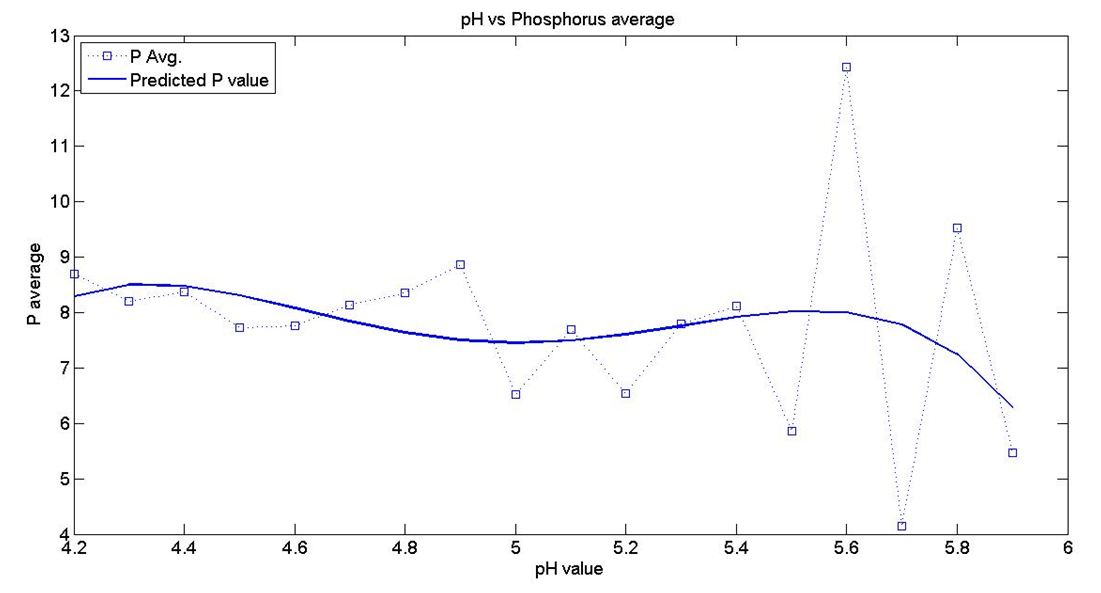 | Figure 1. Relationship between soil phosphorous and pH |
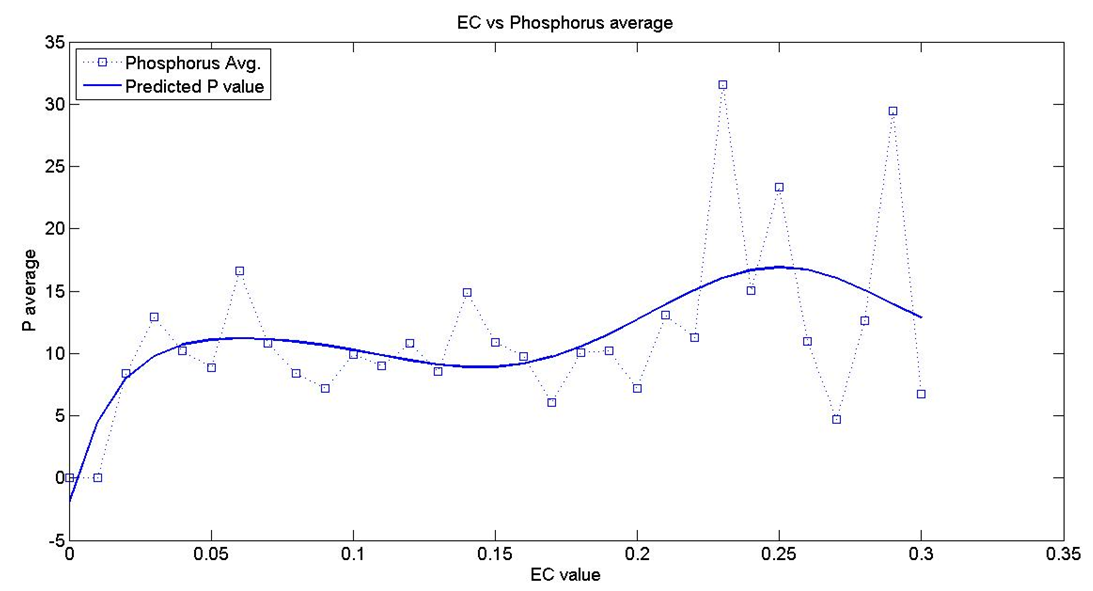 | Figure 2. Relationship between soil phosphorous and EC |
3.2. Proposed Instrument
Figure 3 below shows the block diagram for proposed solution with Controller. | Figure 3. Block diagram for the proposed instrument |
Figure 4 shows the constructed soil nutrient testing instrument. The instrument is powered by 12V, 3000mah battery and its weight is about 600g making that it is usable in the field.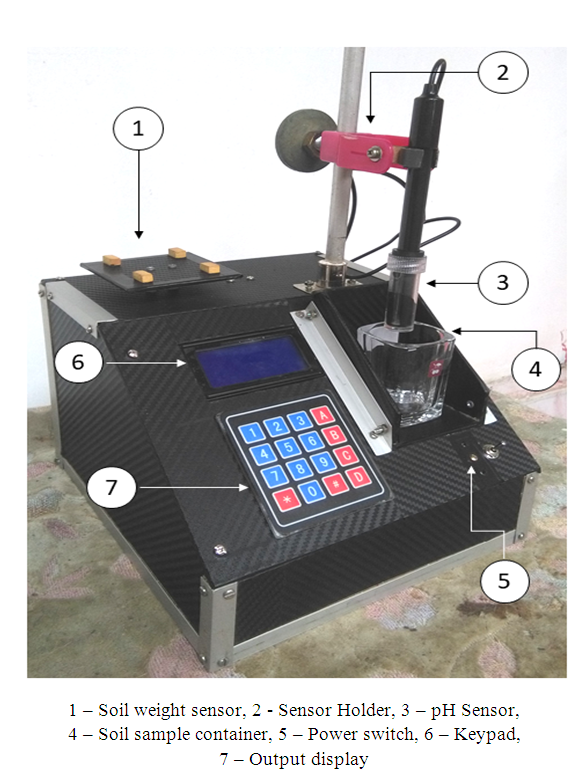 | Figure 4. Soil Nutrient Testing Equipment |
In the operation user must first get a sample of soil weighing 10g and dissolve in 25 ml of distilled water. Then the sample is placed in the instrument and insert the sensor probe. The complete flow chart for operation is given in Figure 5. | Figure 5. Flow Chart |
3.3. Test results
Field tests were conducted to compare the pH, P, K, and OM readings of the instrument with the tests carried out in the laboratory. Figures 7 – 10 show how the instrument readings compare with the laboratory test data for random samples obtained from a paddy field. Prior to testing, the pH senor was calibrated by using standard procedure in the Laboratory. 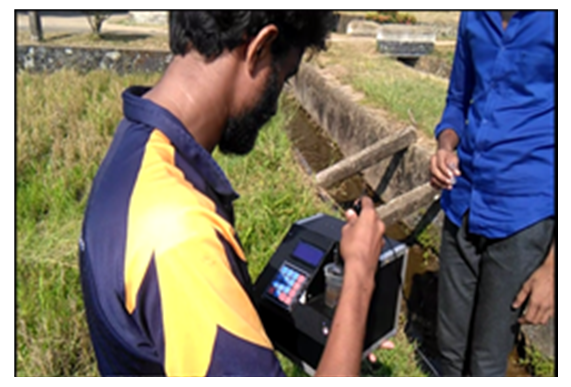 | Figure 6. Testing in the Field |
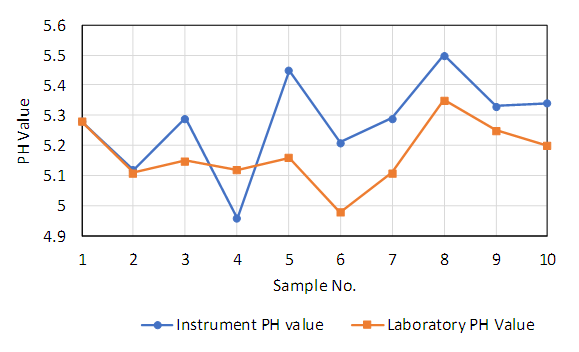 | Figure 7. Comparison of Instrument pH values |
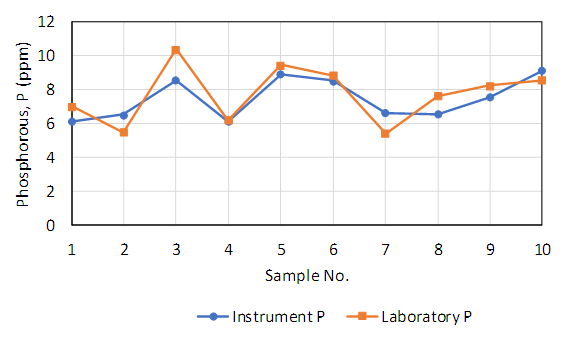 | Figure 8. Comparison of Instrument Phosphorous |
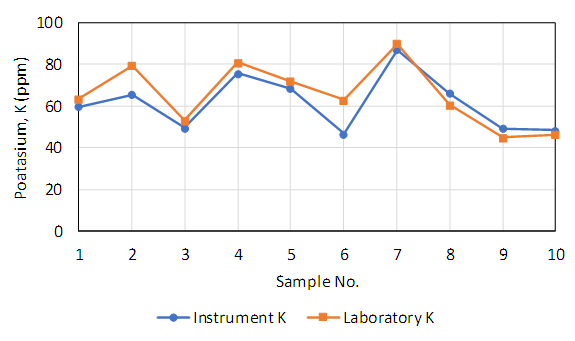 | Figure 9. Comparison of Instrument Potassium |
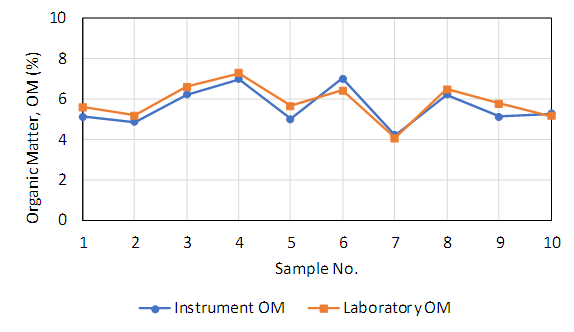 | Figure 10. Comparison of Instrument Organic Matter |
According to the field trails soil phosphorous, potassium, and organic matter showed (Figures 8, 9 and 10) very close resemblances to the test results carried out in the laboratory and this accuracy is sufficient for the decision making on how much each fertilizer need to be added to the soil depending upon the crop requirement. However, the measurement of pH value did not show same accuracy as for other parameters as shown in Figure 7. The maximum deviation from the laboratory test value was found to be 6% higher, and the minimum being zero percent. It was proved by conducting field test that measurements carried out using the instrument showed high correlation with the laboratory test values of the same soil. After obtaining the values for pH, P, K and OM, these values are compared with the recommended values for paddy and the equipment displays the amounts each fertilizer to be added to the paddy field in the form of fertilizer.
4. Conclusions
The instrument fabricated for rapid assessment of soil phosphorus, potassium and organic matter in the field by replacing laboratory tests were found to be successful. These soil data obtained for a field are quite enough for making recommendations on the amounts of external fertilizer to be added to the soil depending upon the crop requirement.At present the equipment has been loaded with data related to rice cultivation, hence the equipment provides the amounts of fertilizers to be added in terms of P and K together with desirable pH value. It is possible to add data related to other crops as well as information of commercially available fertilizers so that instrument provides the feedback in terms of fertilizer requirements rather than individual chemical components. This equipment will be useful for the agriculture extension offers to advice the farmers on the correct dosage of fertilizer after rapid assessment of prevailing nutrient levels of the soil.As the relationships of Phosphorous, Potassium and organic matter with the electrical conductivity of soil have been established based on past records similar to pH values and programmed in to the controller of the instrument, field tests can be carried out with the use of a calibrated senor by replacing the pH sensor, which will consolidate the accuracy of the equipment.
ACKNOWLEDGEMENTS
Authors wish to acknowledge the support extended by the Director and the officers of the Rice Research Centre, Bombuwala, Kaluthara, Sri Lanka by providing past records of soil nutrient parameters, and providing facilities to conduct laboratory tests.
References
| [1] | Stewart, W. M., Dibb, D. W., Johnston, A. E., Smyth, T. J., The Contribution of Commercial Fertilizer Nutrients to Food Production, Agronomy Journal, 97(1), 01 January 2005. |
| [2] | Solution Center for Nutrient Management. Crop Nutrient Requirements, Viewed 11 August 2020, https://ucanr.edu/sites/Nutrient_Management_Solutions/stateofscience/Meet_Crop_Nutrient_Requirements/. |
| [3] | M. Káš, G. Mühlbachová, H. Kusá, M. Pechová, Soil phosphorus and potassium availability in long-term field experiments with organic and mineral fertilization, Plant Soil Environ, Vol. 62, 2016, No. 12: 558–565. |
| [4] | Dimkpa, C., Bindraban, P., McLean, J. E., Gatere, L., Singh, U., Hellums, D., Chapter. 1: Methods for Rapid Testing of Plant and Soil Nutrients, In: Sustainable Agriculture Reviews, Sustainable Agriculture, E. Lichtfouse (Ed), Springer International Publishing AG 2017. |
| [5] | Savci, S., Investigation of Effect of Chemical Fertilizers on Environment, ICESD 2012: 5-7 January 2012, Hong Kong, Elsevier, APCBEE Procedia 1 (2012) 287 – 292. Available online at www.sciencedirect.com. |
| [6] | Burton, L., Jayachandran, K., and Bhansali1, S. Review — The “Real-Time” Revolution for In-situ Soil Nutrient Sensing, A Review, Journal of The Electrochemical Society, 2020, Volume 167, Number 3. |
| [7] | Mohd-Aizat, A., Mohamad-Roslan, M. K., Wan Nor Azmin Sulaiman, Karam, D. S., The relationship between soil pH and selected soil properties in 48 years logged-over forest, International Journal of Environmental Sciences, Volume 4, No 6, 2014. |
| [8] | Li, X., Li, F., Bhupinderpal- Singh, Rengel, Z., and Zhan, Z., Soil management changes organic carbon pools in alpine pastureland soils. Soil Tillage and Research, 93(2007), 186–196. |



















 Abstract
Abstract Reference
Reference Full-Text PDF
Full-Text PDF Full-text HTML
Full-text HTML